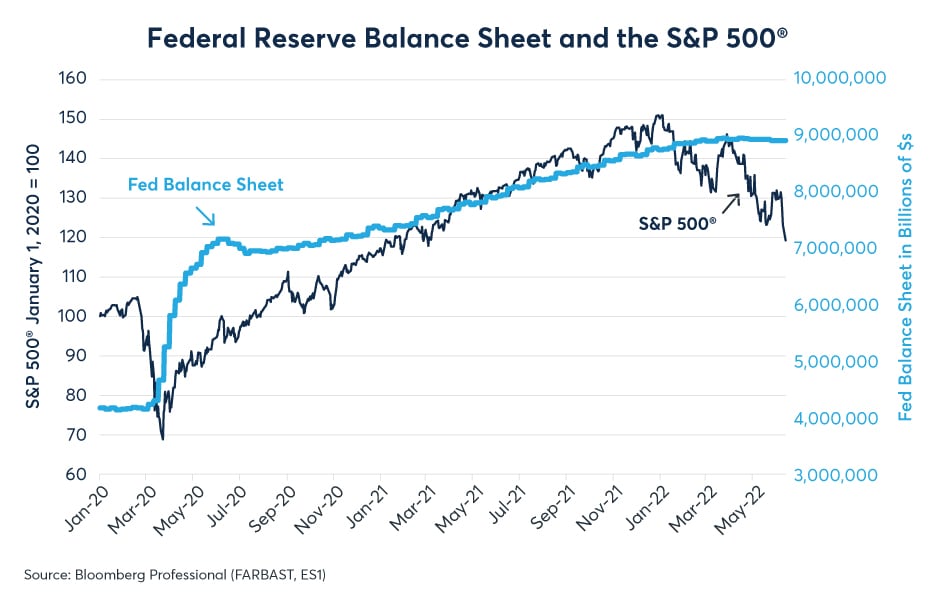On June 1, 2022, the Federal Reserve (Fed) began a program of quantitative tightening (QT), reducing its balance sheet by $45 billion per month over the summer. It plans to accelerate the winding down to $90 billion per month starting September 1. The Fed’s plans could always change, but with headline inflation running at 8.6%, and at 6.0% when excluding food and energy, it is unlikely the Fed might pull back from tightening monetary policy even if equities slide further.
QT has its most direct impact on the bond market, where the Fed is stepping back from asset purchases and slowly allowing its nearly $9-trillion balance sheet to shrink. But equity investors appear to be paying close attention as well. In March 2020, when the Fed launched its pandemic-related quantitative easing (QE) program, it expanded its balance sheet by $3.0 trillion in three months before slowing its pace of purchases to $120 billion per month.

Scan the above QR code for more expert analysis of market events and trends driving opportunities today!
In total, the Fed expanded its balance sheet by $4.8 trillion. Equities rallied strongly as the Fed expanded its balance sheet in 2020 and 2021 but they have been retreating since the beginning of the year as investors anticipated that the Fed would reverse course as inflation surged (Figure 1).
Figure 1: Visually, it seems that the S&P 500 got a boost from QE but by how much?

In financial economics, it can be difficult to prove cause and effect. Did the Fed’s QE cause the S&P 500® to rally? Was the anticipated QT a cause of its recent decline? Will continued QT potentially deepen the equity bear market? While these questions cannot be answered with certainty, S&P 500® Annual Dividend Index Futures might provide a clue.
At first glance the relationship between the S&P 500 Annual Dividend Index Futures and the S&P 500 itself is not entirely obvious. If one adds up the value of the 11 annual contracts and compares it to the S&P 500 there doesn’t appear to be a close connection between the two. In fact, since the beginning of 2017, S&P 500 Annual Dividend Index Futures have barely changed their view of dividends over the next decade. In early 2017, they priced that the S&P 500 would pay around 540 index points worth of dividends over the decade from 2017 to 2027. As of mid-June 2022, they price about 550 index points worth of dividends to be paid over the decade from 2022 to 2032. In contrast with the stability of investor expectations for dividends, the S&P 500 itself rallied from 2,200 to over 4,700 before falling back to 3,800 (Figure 2).
Figure 2: Expected (nominal) dividends have been less volatile than stocks

However, it’s not the nominal dividends that are the most interesting but rather the net present value (NPV) of future dividends as implied from S&P 500 Annual Dividend Index Futures discounted using U.S. Treasury yields. Prior to the Fed beginning its pandemic QE program, the S&P 500 moved more-or-less in lockstep with the NPV of expected dividends as priced into the S&P 500 Annual Dividend Index Futures contracts (Figure 3).
Figure 3: The NPV of anticipated dividends moved in lockstep with stocks until QE

Indeed, this implies that much of the reason why stocks went higher in 2019 and early 2020 was because interest rates were falling, thus raising the NPV of anticipated future dividends. In late February and early March 2020, the NPV of the dividends and equities fell together. However, starting in late March 2020, as the Fed began expanding its balance sheet, the two series diverged. Stocks soared far beyond the levels suggested by the NPV of dividends. By late 2021 the NPV of dividends implied an S&P 500 fair value of perhaps 3,800 while the index rose to almost 4,800.
The NPV of anticipated dividends peaked in November 2021, about a month and a half before the peak in the S&P 500. Since then, the NPV of future dividends has fallen for two reasons:
- Investors have become less optimistic about nominal dividend payments than they were expecting are few months ago.
- Bond yields have soared as inflation has proven to be persistent, and the Fed has begun to hike rates (Figure 4).
Figure 4: Bond yields have surged past their 2018 highs

Even so, the S&P 500 remains far above its pre-pandemic/pre-QE ratio versus the NPV of future dividends. This suggests a risk that as the Fed shrinks its balance sheet (QT) equity prices risk catching up to the NPV of dividends on the downside. If stocks returned to their pre-pandemic/pre-QE ratio versus the NPV of future dividends today, that would imply an S&P 500 of around 2,700 or about one third below recent levels. This isn’t to suggest that the S&P 500 should or is likely to drop that far, but rather to highlight the potential risk that QT poses to equity investors if the pandemic QE did, in fact, inflate asset values as the abrupt change in the ratio between the S&P 500 and the NPV of future dividends suggests may have been the case.
What is clear is that over a long period of time there has been an inverse relationship between the level of bond yields and various valuation measures for the equity market. For example, when long-term bond yields were low during the 1960s, the equity market supported a high market cap-to-GDP ratio. The same has been true in recent decades. By contrast, in the higher inflation and interest rate environment of the 1970s and 1980s, equities had much lower market-cap-to-GDP ratios (Figure 5).
Figure 5: A 40-year downtrend in bond yields boosted equity valuations. Is it over?

High expected inflation and bond yields reduce the NPV of future cash flows, including dividends. Additionally, higher bond yields might also attract investors away from equities and into government bonds. Both of these are reasons why higher rates of inflation and higher bond yields pose a potential threat to equity valuations.
This post contains sponsored advertising content. This content is for informational purposes only and not intended to be investing advice.
© 2025 Benzinga.com. Benzinga does not provide investment advice. All rights reserved.
Trade confidently with insights and alerts from analyst ratings, free reports and breaking news that affects the stocks you care about.